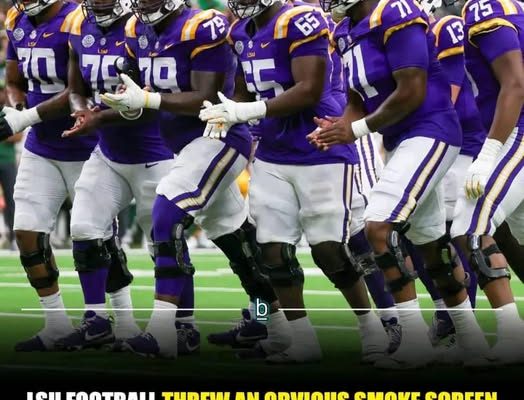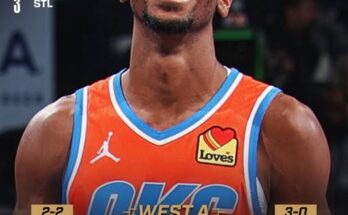LSU enters the 2025 college football season with a sense of urgency and belief that hasn’t been this strong since the national championship run in 2019. The message is simple and clear from inside the program: this team expects to compete for and win a national title. Head coach Brian Kelly, now in his fourth season in Baton Rouge, has publicly stated that the expectation is to take the next step and finally break into the College Football Playoff. For LSU’s players, coaches, and fans, nothing short of that will be considered a success.
The optimism stems from a high-powered offense that brings back a proven quarterback, an arsenal of skill-position talent, and a defense that looks significantly improved under a second-year coordinator. There’s real momentum behind this team—internally and externally—and the pieces appear to be in place for a playoff run. However, even with all that firepower, there’s one glaring concern that could quietly undermine all of it: the offensive line.
It’s not a unique problem. In fact, a majority of college football programs across the country face a similar dilemma—fielding an elite, cohesive, and experienced offensive line is one of the toughest tasks in roster building. Still, for LSU, the stakes are particularly high. With so much else seemingly in position for a title run, the offensive line may be the one unit that determines whether this team lives up to its potential or falls short again.
The confidence starts at quarterback. Garrett Nussmeier returns after a breakout 2024 campaign where he threw for over 4,000 yards and 29 touchdowns. His maturity, arm strength, and poise under pressure have given the Tigers a legitimate Heisman Trophy candidate. What separates Nussmeier from many of his SEC peers is his ability to spread the ball efficiently and push the ball vertically without putting it in harm’s way. He’s smart, quick in his reads, and plays with the demeanor of a veteran. In a league dominated by high-level quarterback play, LSU is one of the few programs that can say, with confidence, that it has an elite signal-caller.
Around Nussmeier is an embarrassment of riches. The wide receiver room is stacked with returning contributors and high-profile transfers. Aaron Anderson leads the group, but LSU has also brought in Barion Brown and Nic Anderson—two dynamic playmakers who can stretch the field and take the top off defenses. At running back, Caden Durham brings physicality and vision, while five-star freshman Harlem Berry is already turning heads in practice with his burst and big-play ability. All signs point to this offense being explosive once again, if not even better than last year.
Defensively, LSU has made significant strides. After a 2023 and 2024 stretch where the defense often lagged behind, the Tigers now enter the season with a more physical and aggressive unit. Linebacker Whit Weeks has emerged as one of the best defenders in the SEC, and the secondary has improved thanks to experienced transfers and better communication in the back end. The defensive front, while still young in spots, is deeper and faster than in previous seasons. Coordinator Blake Baker, in his second year leading the unit, seems to have found the right blend of personnel and scheme.
The coaching staff, too, seems aligned. Brian Kelly has surrounded himself with assistants who understand SEC football and can develop talent. The infrastructure is solid. The facilities are elite. The expectations are sky-high.
It’s not that the line lacks potential—quite the opposite. The issue is that it’s full of unproven pieces trying to replace what was arguably the best offensive line in college football last season. LSU’s 2024 line was experienced, physical, and elite in pass protection. Tackles Will Campbell and Emery Jones Jr. were anchors on the edge and both headed to the NFL as early-round picks. Guards Garrett Dellinger and Miles Frazier were reliable veterans who provided leadership and consistency. Together, that group allowed LSU to finish among the best in the nation in sacks allowed and quarterback pressures.
However, they struggled in the run game. Despite the line’s reputation, LSU finished near the bottom of the SEC in rushing offense, often relying too heavily on the passing game to move the ball. That inability to dominate on the ground foreshadowed a deeper issue—when the line couldn’t impose its will, LSU’s offense became one-dimensional and easier to contain against top-tier opponents.
Now, four of the five starters from that unit are gone. Only center DJ Chester returns, and even he spent part of last season rotating into the lineup and learning on the job. The rest of the line will be comprised of new faces—either young players developed in-house or transfers brought in to fill immediate needs. That’s where the concern comes in. Continuity and chemistry are essential on the offensive line, and LSU doesn’t have the luxury of building that over time. They’ll be tested right out of the gate with a brutal schedule that includes Clemson, Ole Miss, and Alabama in the first half of the season.
Tyree Adams is expected to step in at left tackle, while redshirt freshman Weston Davis and true freshmen like Carius Curne and Soloman Thomas could see meaningful snaps early. The Tigers also added experienced transfers like Braelin Moore from Virginia Tech and Josh Thompson from Northwestern, hoping that a blend of new talent and experience can gel quickly. But that’s a gamble.
The truth is, you can have the best quarterback and the best skill players in the country, but if your offensive line can’t protect or create running lanes, everything else falls apart. That’s especially true in the SEC, where defensive lines are fast, deep, and punishing. You can’t fake it up front. If LSU’s offensive line isn’t ready for prime time, Nussmeier won’t have time to throw, and the running game will stall before it even starts. That puts pressure on the defense, invites turnovers, and forces the offense into predictable situations.
LSU has dealt with this issue before. There have been seasons—2020 and 2021, in particular—where the talent at skill positions masked serious issues in the trenches. The result was underachievement and frustration. Fans know the signs, and even the most optimistic supporters are quietly nervous about the offensive line entering this year.
This isn’t a matter of lacking talent. The pieces are there. It’s about whether those pieces can be molded into a championship-caliber unit in time. Offensive line coach Brad Davis has a reputation for developing talent, and his role this year may be the most important of anyone on staff. He needs to not only identify the best five but get them working together at a high level—fast.
There’s also the mental aspect. Young linemen make mistakes—false starts, missed assignments, holding penalties—that kill drives and momentum. Those small errors can derail big games, especially in tight matchups where one or two possessions can decide the outcome. LSU’s margin for error is slim. In a division that includes Alabama, Ole Miss, Texas, and Oklahoma, there won’t be time for prolonged growing pains.
But there’s still hope. If the offensive line can hold its own—doesn’t even have to be dominant, just solid—this LSU team has everything else it needs to compete with anyone in the country. The quarterback is ready. The defense is improved. The coaching staff is aligned. The skill talent is elite.



